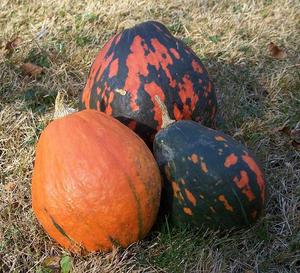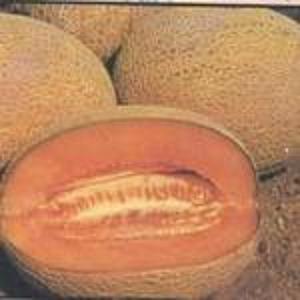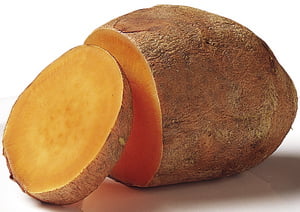LAKOTA SQUASH FOR WINTER STORAGE
Lakota squash is one of the winter storage types of squash. It’s a medium sized, somewhat pear-shaped squash, weighing an average of about seven pounds. The squash are hard-shelled, as are all storage types, and they are dark green splotched with bright orange. Some may be almost entirely either green or orange. The interior flesh is a lovely golden yellow, and it is not stringy. The flavor is nutty and sweet…delicious.
For decorative purposes, Lakota lends a bright touch of natural fall color to any arrangement.
GROW LAKOTA SQUASH
Grow Lakota squash just about anywhere in the US, although in arid regions you will need to provide plenty of irrigation. The vines are large and spreading, with some growing to 20 feet or more in length. Lakota squash plants need to ramble, and they need plenty of garden space. A single leaf on a Lakota squash plant may be two or three feet in diameter.
Plant Lakota squash in the late spring or early summer. The soil should be at least 65 degrees for three days in a row. If it’s warm enough for lima beans to germinate, then it’s fine for Lakota squash. Lakota require 100 days from planting to maturity, so a mid-June planting will give you squash to pick in early October. Plant the seeds in hills or groups with four to six seeds in each. You’ll need a few hills for good pollination, but keep other winter squash varieties at least 50 feet away if you plan on saving seed. The plants need plenty of water throughout the growing season. For an early boost, mix some compost in each hill at planting time. Side dress the plants with compost every two or three weeks, or use a balanced organic fertilizer.
Mulch under the squash vines as they grow to control weeds and to retain moisture. The large leaves shade out most weeds. Add mulch under the fruits as they develop to keep them clean and up off the soil. Straw is a good mulch to use under squash.
Avoid using any insecticides when the plants are blooming, including organic treatments. Hand-pick squash bugs and beetles if you need to during blossom time. The best way to keep insect pests under control is to practice good garden sanitation. Use only well composted material in your garden, and collect plant debris and old vegetables and remove them promptly. This discourages pests that overwinter in garden debris.
STORE LAKOTA SQUASH
You can store Lakota squash in a cool, dry place for three months or more after picking them. Leave about two inches of stem attached to the vegetables when you harvest them to prevent bacteria and mold spores from entering the stem end. Wash and dry the squash to remove excess soil and to prevent bringing pathogens into the storage area. The cut stem end will dry and form a “handle”. Watch for scuffed places on the skin of the squash. Scuffs and small scrapes will usually heal over by forming a pithy scab, which will keep bacteria out. If scrapes do not heal over, use those squash first so they don’t spoil.
SAVE LAKOTA SQUASH SEEDS
Save some of the seeds from your best squash. Sort out some plump, well-filled seeds when you prepare the squash for cooking, and wash them gently in a screen mesh colander under cool running water to remove any clinging orange flesh. The seed coat needs to be intact, so don’t scrape them on the mesh. Spread them out on a paper towel to dry for a few days. Keep the seeds in an envelope or folded paper until planting time next year. Because Lakota squash is not a hybrid, the seeds will grow true to the parent. By saving seeds from your best squash, you will know that the best characteristics of the plant will be passed on to your next crop.
Resource: personal experience







